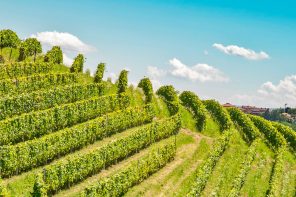In Italy’s northeastern province of Veneto, it seems that red wines get all the love; big, bad Amarone, sickeningly sweet Recioto, and, of course, the everyday, easy-drinking wines of Valpolicella. But when it comes to Veneto, there’s one specific white wine appellation that often (unfairly) gets overlooked. Today, we’re shouting out Soave, Veneto’s cream of the crop appellation for dry, still white wines.
Back in the day, Soave wines (pronounced: soh-WAH-vay) saw some serious international success; so much so, that by the 1970s, Soave wines claimed the title of highest-selling DOC wines in the United States! So what exactly happened that a region with such popularity seems almost unheard of nowadays? In fact, nothing, regarding the quality of the wines. Rather, cheap, mass-produced bulk wines from other regions of Italy, as well as a newfound love for Pinot Grigio, quickly caused the wines’ international sales to be surpassed.
However, not all good things have to come to an end. Currently, the wines of Soave are regaining a stronger international presence, finding their way back onto reputable wine lists and wine shop shelves. After an overwhelming bombardment of mass-produced wines, as well as the gradual refinement of the everyday consumer’s palate, it’s no surprise that the wines of Soave find themselves as a regular presence on the table.
So what exactly are the wines of Soave? According to the DOC, which was created in 1968, the wines of Soave must be white wines produced from at least 70 percent Garganega, an indigenous Italian grape variety. The remaining 30 percent of the blend may be comprised of Trebbiano di Soave (Verdicchio) and/or Chardonnay.
For Soave Classico DOC wines, grapes come from hillside vineyards surrounding the flatlands used to make basic Soave DOC wines. In 2001, an additional Soave Superiore DOCG was created, placing stricter yields on grape harvests, enforcing a minimum 11.5 percent ABV, as well as permitting a few other varieties into the blend. And for Soave Superiore DOCG wines coming from the hills surrounding that area? Call them Soave Colli Scaligeri Superiore DOCG – yes, we know. It’s complicated. And don’t forget the sweet wines of Recioto di Soave, made from slowly fermented, dried out grapes.
Soave wines are produced in the eastern portion of the province of Vicenza, including the hills of the Lessini Mountains. Though the region itself isn’t particularly large, tons of wine comes from this northeastern Italian region. The area is known for its emphasis on terroir, as soil types and microclimates drastically change within short distances. More westerly lying portions of the DOC are rooted in limestone soils, creating crisper, lighter-bodied wines, whereas volcanic, basalt soils dominating the east tend to produce fuller-bodied wines driven by stone fruit flavors.
Whether born in the east or the west, quality wines of Soave definitely improve with age. Peach, citrus and oftentimes floral, flavors in their youth will evolve into honeyed, waxy palates of herbs and jammy stone fruit. Pair with rich seafood, cream-based pasta sauces and savory gnocchi dishes for an unforgettable gastronomical voyage through the Veneto.








